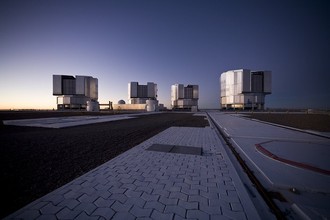
The Nicolaus Copernicus Astronomical Center (NCAC) of the Polish Academy of Sciences is part of an international consortium that has been selected by the European Southern Observatory (ESO) to perform the phase-A study of a new spectrograph for the 8-meter Very Large Telescope (VLT). The consortium is led by INAF (Istituto Nazionale di Astrofisica, Italy), and, in addition to NCAC, includes the STFC-UKATC (UK Astronomy Technology Centre), LSW (Landessternwarte, Zentrum fuer Astronomie der Universitaet Heidelberg, Germany), and IAG-USP (Instituto de Astronomia, Geofísica e Ciências Atmosféricas of the University of São Paulo, Brazil). Dr hab. Rodolfo Smiljanic from NCAC is one of the co-PIs of the consortium.
The new spectrograph is planned to be installed at one Cassegrain focus of the VLT. The goal of the project, called CUBES (http://cubes.inaf.it/home, Cassegrain U-Band Efficient Spectrograph), is to build a high-efficiency instrument covering the ground based ultra-violet wavelength region (300-400 nm) with intermediate resolution (about 20 000). It will bring a large increase of efficiency when compared to current VLT instruments with UV capabilities (UVES and X-Shooter). Such an instrument will remain competitive at the UV wavelengths even in the era of extremely large telescopes (with diameters above 30m), as such facilities are going to be optimized for observations in the red and infrared wavelengths.
The phase-A study has the goals of consolidating the instrument science cases, defining the instrument top-level requirements, and developing a baseline design. The team at NCAC will contribute to the science case studies and in planning the instrument software. The agreement for the phase-A is currently being finalized between INAF and ESO. The phase A will start with a kick-off meeting in the second half of June and last for about one year.
Text: Rodolfo Smiljanic
Picture:
This image of the Paranal platform was taken right after sunset. The four Unit Telescopes are ready to start the observations.
Credit:
ESO/H.H.Heyer






